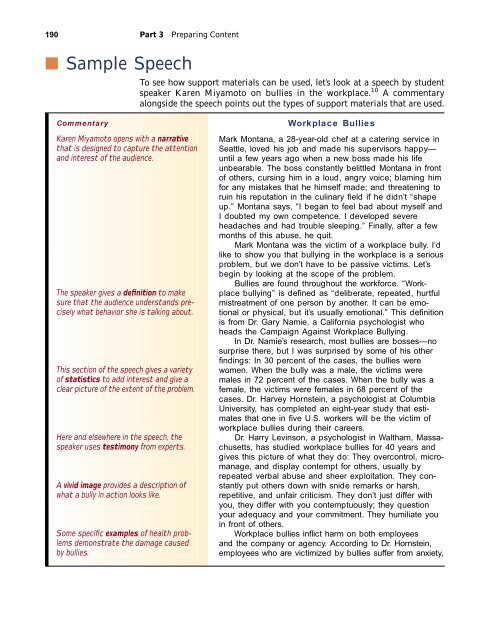Nurul Izzah Anwar, an engineering major at a college in Malaysia ...
Nurul Izzah Anwar, an engineering major at a college in Malaysia ...
Nurul Izzah Anwar, an engineering major at a college in Malaysia ...
You also want an ePaper? Increase the reach of your titles
YUMPU automatically turns print PDFs into web optimized ePapers that Google loves.
190 Part 3 Prepar<strong>in</strong>g Content<br />
■ Sample Speech<br />
Commentary<br />
Karen Miyamoto opens with a narr<strong>at</strong>ive<br />
th<strong>at</strong> is designed to capture the <strong>at</strong>tention<br />
<strong>an</strong>d <strong>in</strong>terest of the audience.<br />
The speaker gives a def<strong>in</strong>ition to make<br />
sure th<strong>at</strong> the audience underst<strong>an</strong>ds precisely<br />
wh<strong>at</strong> behavior she is talk<strong>in</strong>g about.<br />
This section of the speech gives a variety<br />
of st<strong>at</strong>istics to add <strong>in</strong>terest <strong>an</strong>d give a<br />
clear picture of the extent of the problem.<br />
Here <strong>an</strong>d elsewhere <strong>in</strong> the speech, the<br />
speaker uses testimony from experts.<br />
A vivid image provides a description of<br />
wh<strong>at</strong> a bully <strong>in</strong> action looks like.<br />
Some specific examples of health problems<br />
demonstr<strong>at</strong>e the damage caused<br />
by bullies.<br />
To see how support m<strong>at</strong>erials c<strong>an</strong> be used, let’s look <strong>at</strong> a speech by student<br />
speaker Karen Miyamoto on bullies <strong>in</strong> the workplace. 10 A commentary<br />
alongside the speech po<strong>in</strong>ts out the types of support m<strong>at</strong>erials th<strong>at</strong> are used.<br />
Workplace Bullies<br />
Mark Mont<strong>an</strong>a, a 28-year-old chef <strong>at</strong> a c<strong>at</strong>er<strong>in</strong>g service <strong>in</strong><br />
Se<strong>at</strong>tle, loved his job <strong>an</strong>d made his supervisors happy—<br />
until a few years ago when a new boss made his life<br />
unbearable. The boss const<strong>an</strong>tly belittled Mont<strong>an</strong>a <strong>in</strong> front<br />
of others, curs<strong>in</strong>g him <strong>in</strong> a loud, <strong>an</strong>gry voice; blam<strong>in</strong>g him<br />
for <strong>an</strong>y mistakes th<strong>at</strong> he himself made; <strong>an</strong>d thre<strong>at</strong>en<strong>in</strong>g to<br />
ru<strong>in</strong> his reput<strong>at</strong>ion <strong>in</strong> the cul<strong>in</strong>ary field if he didn’t “shape<br />
up.” Mont<strong>an</strong>a says, “I beg<strong>an</strong> to feel bad about myself <strong>an</strong>d<br />
I doubted my own competence. I developed severe<br />
headaches <strong>an</strong>d had trouble sleep<strong>in</strong>g.” F<strong>in</strong>ally, after a few<br />
months of this abuse, he quit.<br />
Mark Mont<strong>an</strong>a was the victim of a workplace bully. I’d<br />
like to show you th<strong>at</strong> bully<strong>in</strong>g <strong>in</strong> the workplace is a serious<br />
problem, but we don’t have to be passive victims. Let’s<br />
beg<strong>in</strong> by look<strong>in</strong>g <strong>at</strong> the scope of the problem.<br />
Bullies are found throughout the workforce. “Workplace<br />
bully<strong>in</strong>g” is def<strong>in</strong>ed as “deliber<strong>at</strong>e, repe<strong>at</strong>ed, hurtful<br />
mistre<strong>at</strong>ment of one person by <strong>an</strong>other. It c<strong>an</strong> be emotional<br />
or physical, but it’s usually emotional.” This def<strong>in</strong>ition<br />
is from Dr. Gary Namie, a California psychologist who<br />
heads the Campaign Aga<strong>in</strong>st Workplace Bully<strong>in</strong>g.<br />
In Dr. Namie’s research, most bullies are bosses—no<br />
surprise there, but I was surprised by some of his other<br />
f<strong>in</strong>d<strong>in</strong>gs: In 30 percent of the cases, the bullies were<br />
women. When the bully was a male, the victims were<br />
males <strong>in</strong> 72 percent of the cases. When the bully was a<br />
female, the victims were females <strong>in</strong> 68 percent of the<br />
cases. Dr. Harvey Hornste<strong>in</strong>, a psychologist <strong>at</strong> Columbia<br />
University, has completed <strong>an</strong> eight-year study th<strong>at</strong> estim<strong>at</strong>es<br />
th<strong>at</strong> one <strong>in</strong> five U.S. workers will be the victim of<br />
workplace bullies dur<strong>in</strong>g their careers.<br />
Dr. Harry Lev<strong>in</strong>son, a psychologist <strong>in</strong> Waltham, Massachusetts,<br />
has studied workplace bullies for 40 years <strong>an</strong>d<br />
gives this picture of wh<strong>at</strong> they do: They overcontrol, microm<strong>an</strong>age,<br />
<strong>an</strong>d display contempt for others, usually by<br />
repe<strong>at</strong>ed verbal abuse <strong>an</strong>d sheer exploit<strong>at</strong>ion. They const<strong>an</strong>tly<br />
put others down with snide remarks or harsh,<br />
repetitive, <strong>an</strong>d unfair criticism. They don’t just differ with<br />
you, they differ with you contemptuously; they question<br />
your adequacy <strong>an</strong>d your commitment. They humili<strong>at</strong>e you<br />
<strong>in</strong> front of others.<br />
Workplace bullies <strong>in</strong>flict harm on both employees<br />
<strong>an</strong>d the comp<strong>an</strong>y or agency. Accord<strong>in</strong>g to Dr. Hornste<strong>in</strong>,<br />
employees who are victimized by bullies suffer from <strong>an</strong>xiety,

















